CHEVROLET CAMARO 1967 1.G Chassis Workshop Manual
Manufacturer: CHEVROLET, Model Year: 1967, Model line: CAMARO, Model: CHEVROLET CAMARO 1967 1.GPages: 659, PDF Size: 114.24 MB
Page 311 of 659

ENGINE FUEL 6M-3
Idle Speed and Mixture Adjustment (With Air Injection
Reactor System)
The following is the recommended procedure for Air
Injection Reactor System equipped engines.
NOTE: This adjustment should be performed
with engine at operating temperature and parking
brake applied.
1.
Remove air cleaner.
2.
Connect tachometer to engine, then set hand brake
and shift transmission into neutral.
3.
As a preliminary adjustment, turn idle mixture
screws lightly to seat and back out 3 turns.
CAUTION: Do not turn idle mixture screw
tightly against seat or damage may result."
4.
With engine running (choke wide open) adjust idle
speed screw to specified idle speed. (Automatic
transmission in dirve, synchronized transmission in
neutral).
5.
Adjust idle mixture screw (turn in) to "lean roll"
position; then turn screw out 1/4 turn (1/4 turn
rich from "lean roll"). The definition of "lean
roll" point is a 20 to 30 rpm drop in engine speed,
obtained by leaning the idle mixture.
NOTE: On air conditioned vehicles, turn air
conditioning "OFF" on in-line, 283, 327, and'
350 cu. in. engines, and turned "ON" and hot
idle compensator held closed on 396 and 427 cu.
in. engines.
6. Repeat Steps 4 and 5 as needed for final adjustment.
NOTE: If necessary, final adjustment of the
carburetor may be made with air cleaner
installed.
7.
Shut down the engine, remove gauges and install air
cleaner. *
Fast Idle Adjustment
Rochester
4MV and Holley
With fast idle lever on high step of cam and choke valve
open (engine warm) set fast idle to give specified engine
rpm. Adjust sejrew on Rochester 4MV and bend fast
idle lever *pn Holley. .
Choke Adjustment
With Remote Choke (Fig. 2c)
1.
Remove air cleaner and check to see that choke
valve and rod move freely.
2.
Disconnect choke rod at choke lever.
3.
Check choke adjustment as follows:
On all except 275 and 300 h.p. 327 cu. in. engines,
hold choke valve closed and pull.rod up against stop.
The top of choke rod end should be 1/2-1 rod diame-
ter above top of hole in choke valve lever.
On 275 and 300 h.p. 327 cu. in. engines, hold choke
valve closed and push rod down against stop on ther-
mostat bracket. The top of the choke rod should be
1/2-1 rod diameter below the top of the hole in the
choke lever.
4.
If necessary, adjust rod length by bending rod at
offset bend. (Bend must be such that rod enters
choke lever hole freely and squarely).
5.
Connect rod at choke lever and install air cleaner.
With Manual Choke (Carter YF)
1.
Remove air cleaner.
CHOKE VALVE
COMPLETELY
CLOSED
PULL UPWARD ON
ROD TO END OF
TRAVEL
BEND ROD
TO ADJUST
ROD IN BOTTOM
OF SLOT
BOTTOM OF
ROD SHOULD
BE EVEN WITH
TOP OF
HOLE
CHOKE VALVE
CLOSED
BOTTOM OF
ROD SHOULD
BE EVEN WITH
TOP OF HOLE
TOP OF ROD
SHOULD BE EVEN
WITH BOTTOM
OF HOLE (CHOKE
CLOSED)
BEND ROD TO
ADJUST
PULL DOWNWARD'
ON ROD TO CON-
TACT STOP
L6 (TYPICAL)
[
V8 327-275 HP
V8 350-295 HP
BEND ROD
TO ADJUST
PULL UPWARD ON
ROD TO CONTACT
STOP ON BRACKET
ALL V8 (EXCEPT 327-275 HP
AND 350-295 HP)
Fig.
2C—Remote Choke Adjustment
CHEVROLET CHASSIS SERVICE MANUAL
Page 312 of 659
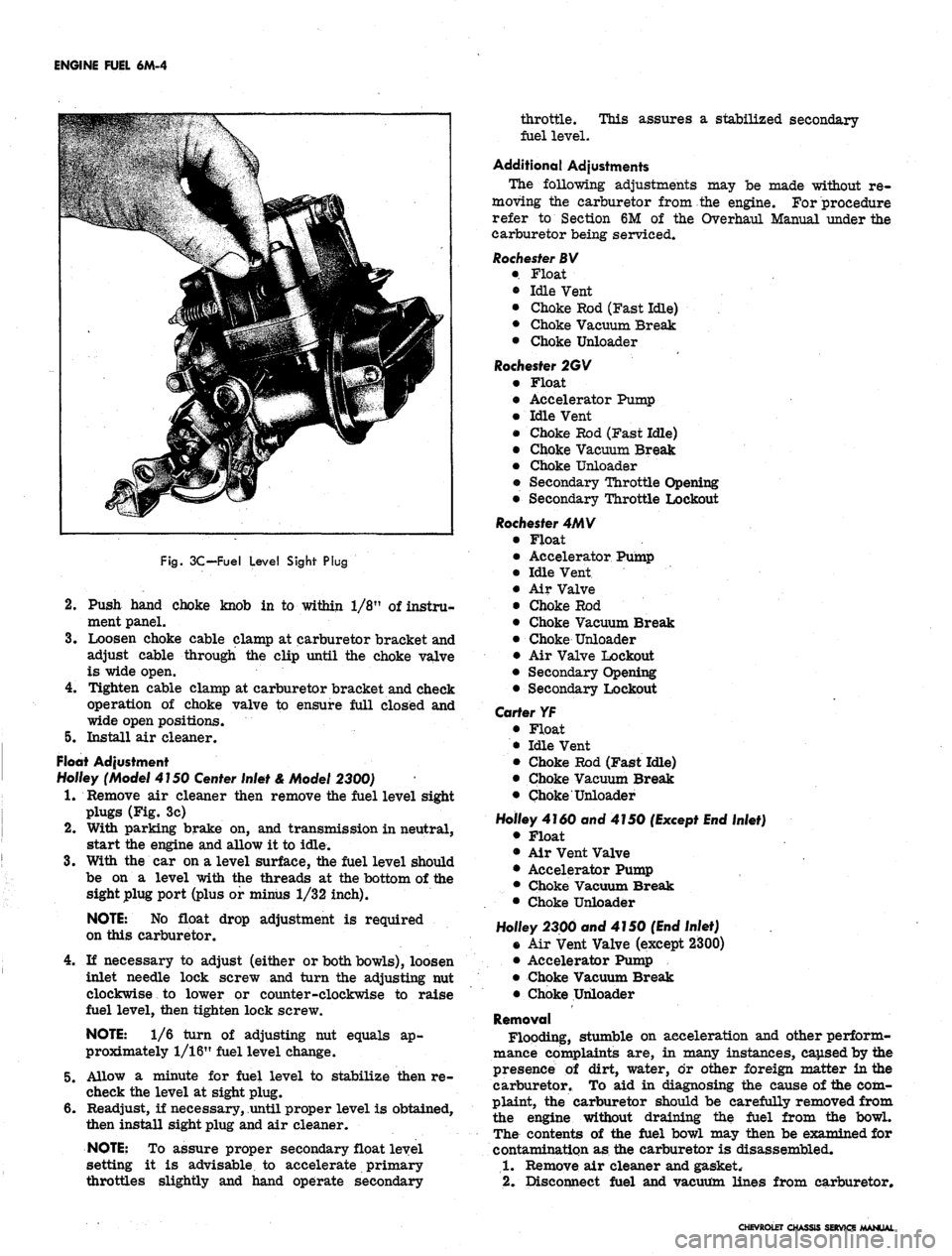
ENGINE FUEL 6M-4
Fig.
3C-Fuel Level Sight Plug
2.
Push hand choke knob in to within 1/8" of instru-
ment panel.
3.
Loosen choke cable clamp at carburetor bracket and
adjust cable through the clip until the choke valve
is wide open.
4.
Tighten cable clamp at carburetor bracket and check
operation of choke valve to ensure full closed and
wide open positions.
5. Install air cleaner.
Float Adjustment
Ho/fey (Model 4150
Center
Inlet & Model 2300)
1.
Remove air cleaner then remove the fuel level sight
plugs (Fig. 3c)
2.
With parking brake on, and transmission in neutral,
start the engine and allow it to idle.
3.
With the car on a level surface, the fuel level should
be on a level with the threads at the bottom of the
sight plug port (plus or minus 1/32 inch).
NOTE:
No float drop adjustment is required
on this carburetor.
4.
If necessary to adjust (either or both bowls), loosen
inlet needle lock screw and turn the adjusting nut
clockwise to lower or counter-clockwise to raise
fuel level, then tighten lock screw.
NOTE:
1/6 turn of adjusting nut equals ap-
proximately 1/16" fuel level change.
5. Allow a minute for fuel level to stabilize then re-
check the level at sight plug.
6. Readjust, if necessary, until proper level is obtained,
then install sight plug and air cleaner.
NOTE:
To assure proper secondary float level
setting it is advisable to accelerate primary
throttles slightly and hand operate secondary
throttle. This assures a stabilized secondary
fuel level.
Additional Adjustments
The following adjustments may be made without re-
moving the carburetor from the engine. For procedure
refer to Section 6M of the Overhaul Manual under the
carburetor being serviced.
Rochester BV
• Float
• Idle Vent
• Choke Rod (Fast Idle)
• Choke Vacuum Break
• Choke Unloader
Rochester 2GV
• Float
• Accelerator Pump
• Idle Vent
• Choke Rod (Fast Idle)
• Choke Vacuum Break
• Choke Unloader
• Secondary Throttle Opening
• Secondary Throttle Lockout
Rochester 4MV
• Float
• Accelerator Pumj)
• Idle Vent
• Air Valve
• Choke Rod
• Choke Vacuum Break
• Choke Unloader
• Air Valve Lockout
• Secondary Opening
• Secondary Lockout
Carter YF
• Float
• Idle Vent
• Choke Rod (Fast Idle)
• Choke Vacuum Break
• Choke Unloader
Holley 4160 and 4150
(Except End
Inlet)
• Float
• Air Vent Valve
• Accelerator Pump
• Choke Vacuum Break
• Choke Unloader
Holley 2300 and 4150
(End
Inlet)
• Air Vent Valve (except 2300)
• Accelerator Pump
• Choke Vacuum Break
• Choke Unloader
Removal
Flooding, stumble on acceleration and other perform-
mance complaints are, in many instances, caused by the
presence of dirt, water, or other foreign matter in the
carburetor. To aid in diagnosing the cause of the com-
plaint, the carburetor should be carefully removed from
the engine without draining the fuel from the bowl.
The contents of the fuel bowl may then be examined for
contamination as the carburetor is disassembled.
1.
Remove air cleaner and gasket.
2.
Disconnect fuel and vacuum lines from carburetor.
CHEVROLET CHASSIS SERVICE MANUAL
Page 313 of 659
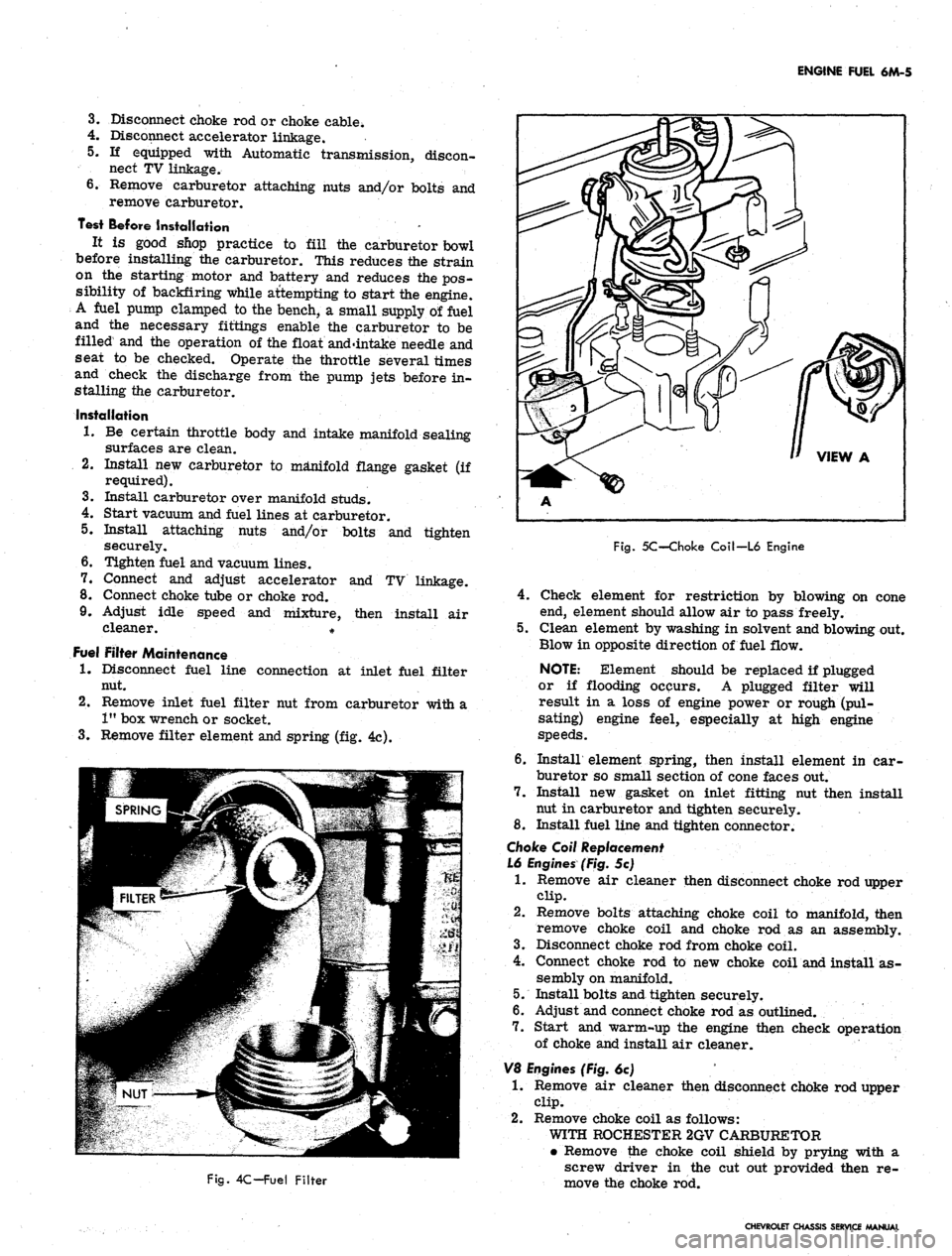
ENGINE FUEL 6M-5
3.
Disconnect choke rod or choke cable.
4.
Disconnect accelerator linkage.
5.
If equipped with Automatic transmission, discon-
nect TV linkage.
6. Remove carburetor attaching nuts and/or bolts and
remove carburetor.
Test Before Installation -
It is good shop practice to fill the carburetor bowl
before installing the carburetor. This reduces the strain
on the starting motor and battery and reduces the pos-
sibility of backfiring while attempting to start the engine.
A fuel pump clamped to the bench, a small supply of fuel
and the necessary fittings enable the carburetor to be
filled1 and the operation of the float and'intake needle and
seat to be checked. Operate the throttle several times
and check the discharge from the pump jets before in-
stalling the carburetor.
Installation
1.
Be certain throttle body and intake manifold sealing
surfaces are clean.
2.
Install new carburetor to manifold flange gasket (if
required).
3.
Install carburetor over manifold studs.
4.
Start vacuum and fuel lines at carburetor.
5.
Install attaching nuts and/or bolts and tighten
securely.
6. Tighten fuel and vacuum lines.
7.
Connect and adjust accelerator and TV linkage.
8. Connect choke tube or choke rod.
9. Adjust idle speed and mixture, then install air
cleaner. #
Fuel Filter Maintenance
1.
Disconnect fuel line connection at inlet fuel filter
nut.
2.
Remove inlet fuel filter nut from carburetor with a
1"
box wrench or socket.
3.
Remove filter element and spring (fig. 4c).
Fig. 5C-Choke Coil-L6 Engine
4.
Fig. 4C-Fuel Filter
Check element for restriction by blowing on cone
end, element should allow air to pass freely.
5.
Clean element by washing in solvent and blowing out.
Blow in opposite direction of fuel flow.
NOTE: Element should be replaced if plugged
or if flooding ocpurs. A plugged filter will
result in a loss of engine power or rough (pul-
sating) engine feel, especially at high engine
speeds.
6. Install element spring, then install element in car-
buretor so small section of cone faces out.
7.
Install new gasket on inlet fitting nut then install
nut in carburetor and tighten securely.
8. Install fuel line and tighten connector.
Choke Coil Replacement
L6 Engines (Fig. 5c)
1.
Remove air cleaner then disconnect choke rod upper
clip.
2.
Remove bolts attaching choke coil to manifold, then
remove choke coil and choke rod as an assembly.
3.
Disconnect choke rod from choke coil.
4.
Connect choke rod to new choke coil and install as-
sembly on manifold.
5.
Install bolts and tighten securely.
6. Adjust and connect choke rod as outlined.
7.
Start and warm-up the engine then check operation
of choke and install air cleaner.
V8 Engines (Fig. 6c)
1.
Remove air cleaner then disconnect choke rod upper
clip.
2.
Remove choke coil as follows:
WITH ROCHESTER 2GV CARBURETOR
• Remove the choke coil shield by prying with a
screw driver in the cut out provided then re-
move the choke rod.
CHEVROLET CHASSIS SERVICE MANUAL
Page 314 of 659
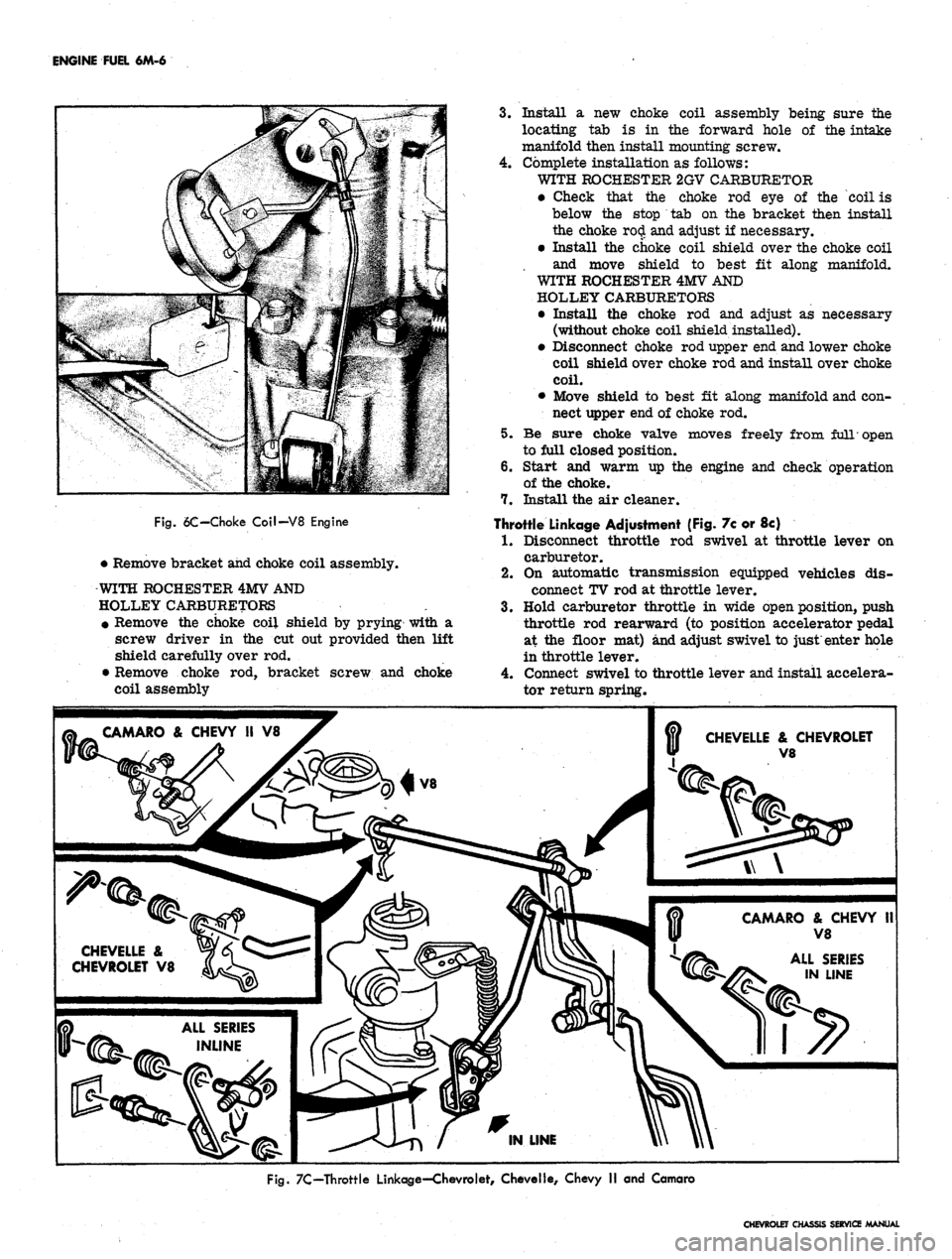
ENGINE FUEL 6M-6
Fig.
6C-Choke Coil-V8 Engine
• Remove bracket and choke coil assembly.
WITH ROCHESTER 4MV AND
HOLLEY CARBURETORS
• Remove the choke coil shield by prying with a
screw driver in the cut out provided then lift
shield carefully over rod.
• Remove choke rod, bracket screw and choke
coil assembly
3.
Install a new choke coil assembly being sure the
locating tab is in the forward hole of the intake
manifold then install mounting screw.
4.
Complete installation as follows:
WITH ROCHESTER 2GV CARBURETOR
• Check that the choke rod eye of the coil is
below the stop tab on the bracket then install
the choke
ro
• Install the choke coil shield over the choke coil
and move shield to best fit along manifold.
WITH ROCHESTER 4MV AND
HOLLEY CARBURETORS
• Install the choke rod and adjust as necessary
(without choke coil shield installed).
• Disconnect choke rod upper end and lower choke
coil shield over choke rod and install over choke
coil.
• Move shield to best fit along manifold and con-
nect upper end of choke rod.
5. Be sure choke valve moves freely from full open
to full closed position.
6. Start and warm up the engine and check operation
of the choke.
7. Install the air cleaner.
Throttle Linkage Adjustment (Fig. 7c or 8c)
1.
Disconnect throttle rod swivel at throttle lever on
carburetor.
2.
On automatic transmission equipped vehicles dis-
connect TV rod at throttle lever.
3.
Hold carburetor throttle in wide open position, push
throttle rod rearward (to position accelerator pedal
at the floor mat) and adjust swivel to just enter hole
in throttle lever.
4.
Connect swivel to throttle lever and install accelera-
tor return spring.
CAMARO & CHEVY II V8
CHEVELLE & CHEVROLET
V8
CAMARO
&
CHEVY
II
V8
CHEVELLE &
CHEVROLET V8
ALL SERIES
IN LINE
ALL SERIES
INLINE
Fig.
7C—Throttle Linkage—Chevrolet, Chevelle, Chevy II and Camaro
CHEVROLET CHASSIS SERVICE MANUAL
Page 315 of 659
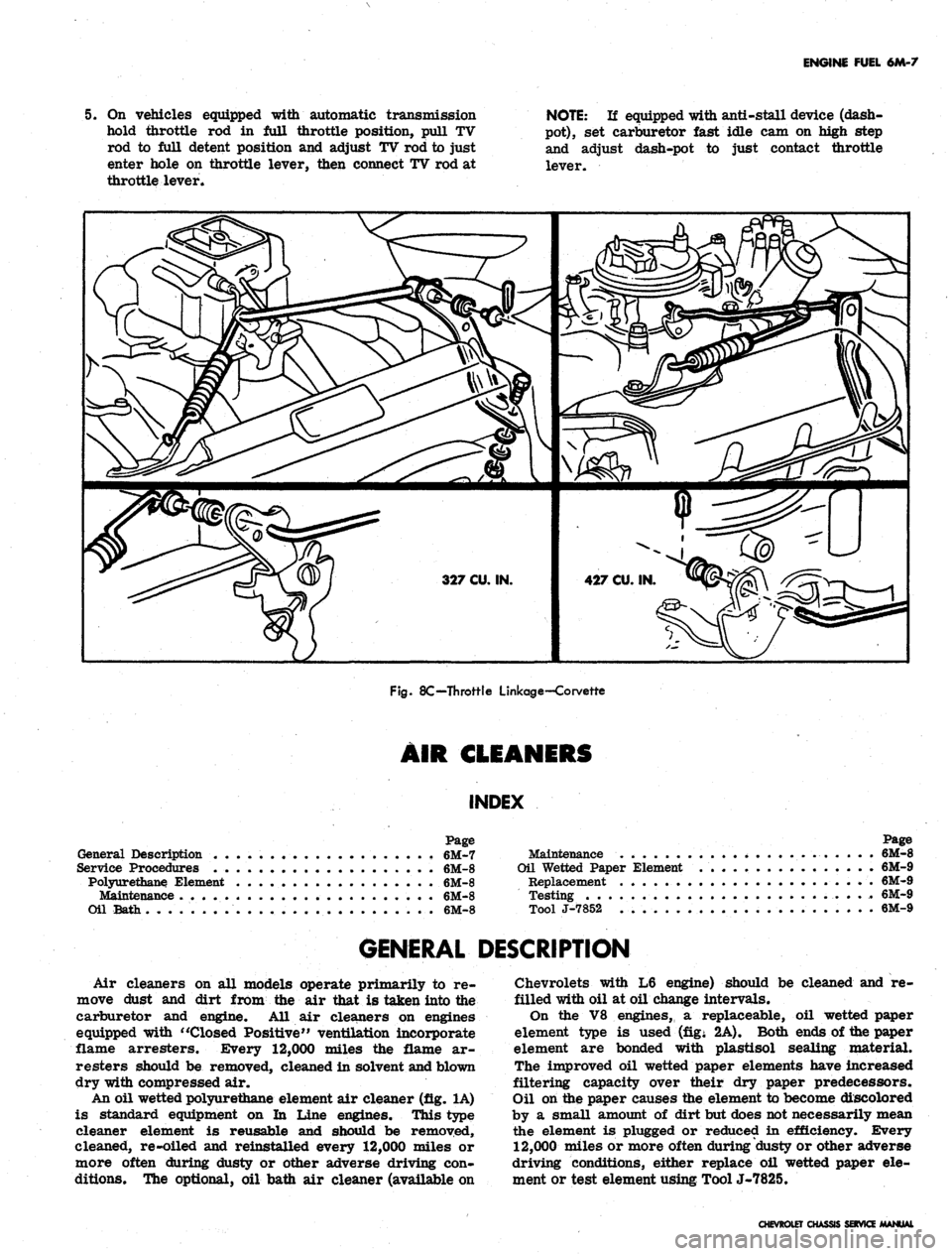
ENGINE FUEL 6M-7
5. On vehicles equipped with automatic transmission
hold throttle rod in full throttle position, pull TV
rod to full detent position and adjust TV rod to just
enter hole on throttle lever, then connect TV rod at
throttle lever.
NOTE:
If equipped with anti-stall device (dash-
pot),
set carburetor fast idle cam on high step
and adjust dash-pot to just contact throttle
lever.
327
CU.
IN.
427
CU.
IN.
Fig.
8C—Throttle Linkage-Corvette
AIR
CLEANERS
INDEX
Page
General Description 6M-7
Service Procedures . . 6M-8
Polyurethane. Element 6M-8
Maintenance 6M-8
Oil Bath 6M-8
Page
Maintenance
...........* 6M-8
Oil
Wetted
Paper
Element
6M-9
Replacement
* . 6M-9
Testing 6M-9
Tool J-7852 . 6M-9
GENERAL DESCRIPTION
Air cleaners on all models operate primarily to re-
move dust and dirt from the air that is taken into the
carburetor and engine. All air cleaners on engines
equipped with "Closed Positive" ventilation incorporate
flame arresters. Every 12,000 miles the flame ar-
resters should be removed, cleaned in solvent and blown
dry with compressed air.
An oil wetted polyurethane element air cleaner (fig. 1A)
is standard equipment on In Line engines. This type
cleaner element is reusable and should be removed,
cleaned, re-oiled and reinstalled every 12,000 miles or
more often during dusty or other adverse driving con-
ditions. The optional, oil bath air cleaner (available on
Chevrolets with L6 engine) should be cleaned and re-
filled with oil at oil change intervals.
On the V8 engines,, a replaceable, oil wetted paper
element type is used (fig; 2A). Both ends of me paper
element are bonded with plastisol sealing material.
The improved oil wetted paper elements have increased
filtering capacity over their dry paper predecessors.
Oil on the paper causes the element to become diBcolored
by a small amount of dirt but does not necessarily mean
the element is plugged or reduced in efficiency. Every
12,000 miles or more often during dusty or other adverse
driving conditions, either replace oil wetted paper ele-
ment or test element using ToolJ-7825.
CHEVROLET CHASSIS SOVICE/MANUAL
Page 316 of 659
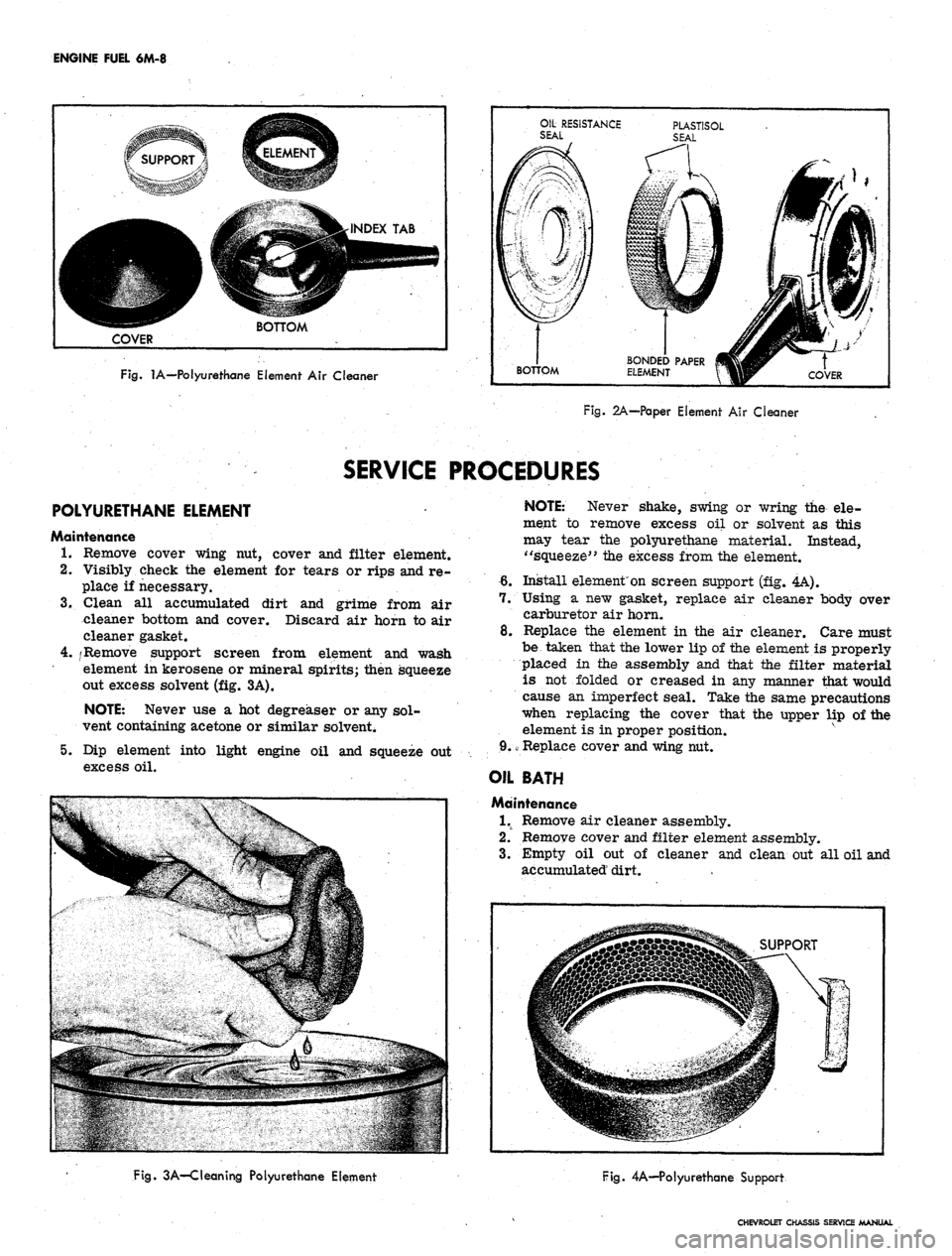
ENGINE FUEL 6M-8
^T^l^^/'-vN
COVER
BOTTOM
Fig. 1A—Polyurethane Element Air Cleaner
OIL RESISTANCE
SEAL
BOTTOM
BONDED PAPER
ELEMENT
COVER
Fig. 2A—Paper Element Air Cleaner
SERVICE
PROCEDURES
POLYURETHANE ELEMENT
Maintenance
1.
Remove cover wing nut, cover and filter element.
2.
Visibly check the element for tears or rips and re-
place if necessary.
3.
Clean all accumulated dirt and grime from air
cleaner bottom and cover. Discard air horn to air
cleaner gasket.
4.
/Remove support screen from element and wash
element in kerosene or mineral spirits; then squeeze
out excess solvent (fig. 3A).
NOTE: Never use a hot degreaser or any sol-
vent containing acetone or similar solvent*
5.
Dip element into light engine oil and squeeze out
excess oil.
NOTE: Never shake, swing or wring the ele-
me.nt to remove excess oil or solvent as this
may tear the polyurethane material. Instead,
"squeeze" the excess from the element.
6. Install element'on screen support (fig. 4A).
7.
Using a new gasket, replace air cleaner body over
carburetor air horn.
8. Replace the element in the air cleaner. Care must
be taken that the lower lip of the element is properly
placed in the assembly and that the filter material
is not folded or creased in any manner that would
cause an imperfect seal. Take the same precautions
when replacing the cover that the upper lip of the
element is in proper position.
9.<•
Replace cover and wing nut.
OIL BATH
Maintenance
L Remove air cleaner assembly.
2.
Remove cover and filter element assembly.
Empty oil out of
accumulated dirt.
cleaner and clean out all oil and
Fig. 3A—Cleaning Polyurethane Element
Fig.
4A—Polyurethane Support
CHEVROLET CHASSIS SERVICE MANUAL
Page 317 of 659
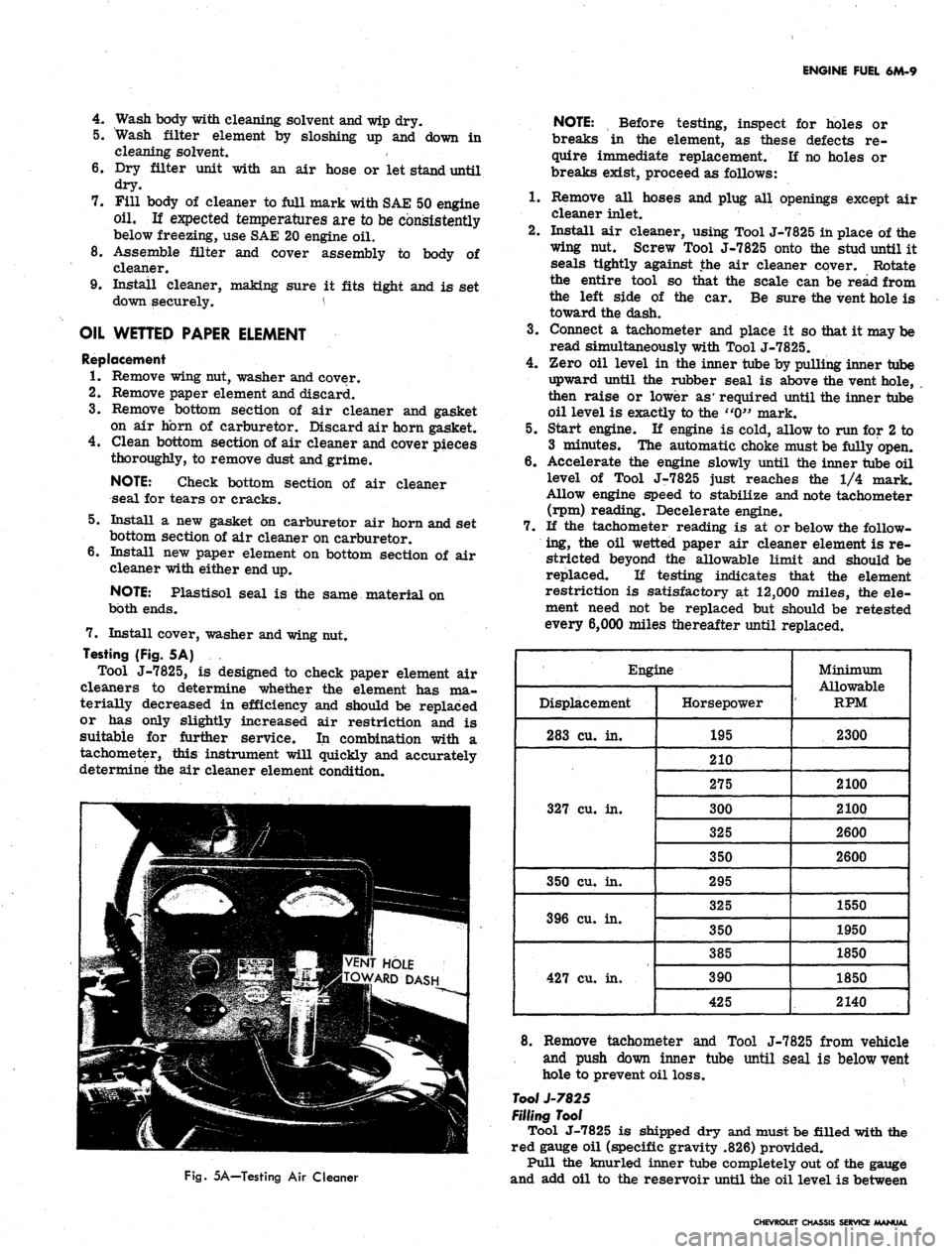
ENGINE FUEL 6M-9
4.
Wash body with cleaning solvent and wip dry.
5. Wash filter element by sloshing up and down in
cleaning solvent.
6. Dry filter unit with an air hose or let stand until
dry.
7. Fill body of cleaner to full mark with SAE 50 engine
oil. If expected temperatures are to be consistently
below freezing, use SAE 20 engine oil.
8. Assemble filter and cover assembly to body of
cleaner.
9. Install cleaner, making sure it fits tight and is set
down securely. \
OIL
WETTED
PAPER
ELEMENT
Replacement
1.
Remove wing nut, washer and cover.
2.
Remove paper element and discard.
3.
Remove bottom section of air cleaner and gasket
on air horn of carburetor. Discard air horn gasket.
4.
Clean bottom section of air cleaner and cover pieces
thoroughly, to remove dust and grime.
NOTE:
Check bottom section of air cleaner
seal for tears or cracks.
5. Install a new gasket on carburetor air horn and set
bottom section of air cleaner on carburetor.
6. Install new paper element on bottom section of air
cleaner with either end up.
NOTE:
Plastisol seal is the same material on
both ends.
7. Install cover, washer and wing nut.
Testing (Fig. 5A)
Tool J-7825, is designed to check paper element air
cleaners to determine whether the element has ma-
terially decreased in efficiency arid should be replaced
or has only slightly increased air restriction and is
suitable for further service. In combination with a
tachometer, this instrument will quickly and accurately
determine the air cleaner element condition.
VENT HOLE
TOWARD DASH
NOTE:
t Before testing, inspect for holes or
breaks in the element, as these defects re-
quire immediate replacement. If no holes or
breaks exist, proceed as follows:
1.
Remove all hoses and plug all openings except air
cleaner inlet.
2.
Install air cleaner, using Tool J-7825 in place of the
wing nut. Screw Tool J-7825 onto the stud until it
seals tightly against the air cleaner cover. Rotate
the entire tool so that the scale can be read from
the left side of the car. Be sure the vent hole is
toward the dash.
3.
Connect a tachometer and place it so that it may be
read simultaneously with Tool J-7825.
4.
Zero oil level in the inner tube by pulling inner tube
upward until the rubber seal is above the vent hole,
then raise or lower as' required until the inner tube
oil level is exactly to the "0" mark.
5. Start engine. If engine is cold, allow to run for 2 to
3 minutes. The automatic choke must be fully open.
6. Accelerate the engine slowly until the inner tube oil
level of Tool J-7825 just reaches the 1/4 mark.
Allow engine speed to stabilize and note tachometer
(rpm) reading. Decelerate engine.
7. If the tachometer reading is at or below the follow-
ing, the oil wetted paper air cleaner element is re-
stricted beyond the allowable limit and should be
replaced. If testing indicates that the element
restriction is satisfactory at 12,000 miles, the ele-
ment need not be replaced but should be retested
every 6,000 miles thereafter until replaced.
Engine
Displacement
283 cu.
in.
327 cu.
in.
350 cu. in.
396 cu.
in.
427 cu.
in.
Horsepower
195
210
275
300
325
350
295
325
350
385
390
425
Minimum
Allowable
RPM
2300
2100
210Q
2600
2600
1550
1950
1850
1850
2140
Fig.
5A—Testing Air Cleaner
8. Remove tachometer and Tool J-7825 from vehicle
and push down inner tube until seal is below vent
hole to prevent oil loss.
Tool J-7825
FiHing
Tool
Tool J-7825 is shipped dry and must be filled with the
red gauge oil (specific gravity .826) provided.
Pull the knurled inner tube completely out of the gauge
and add oil to the reservoir until the oil level is between
CHEVROLET CHASSIS SERVICE /MANUAL
Page 318 of 659
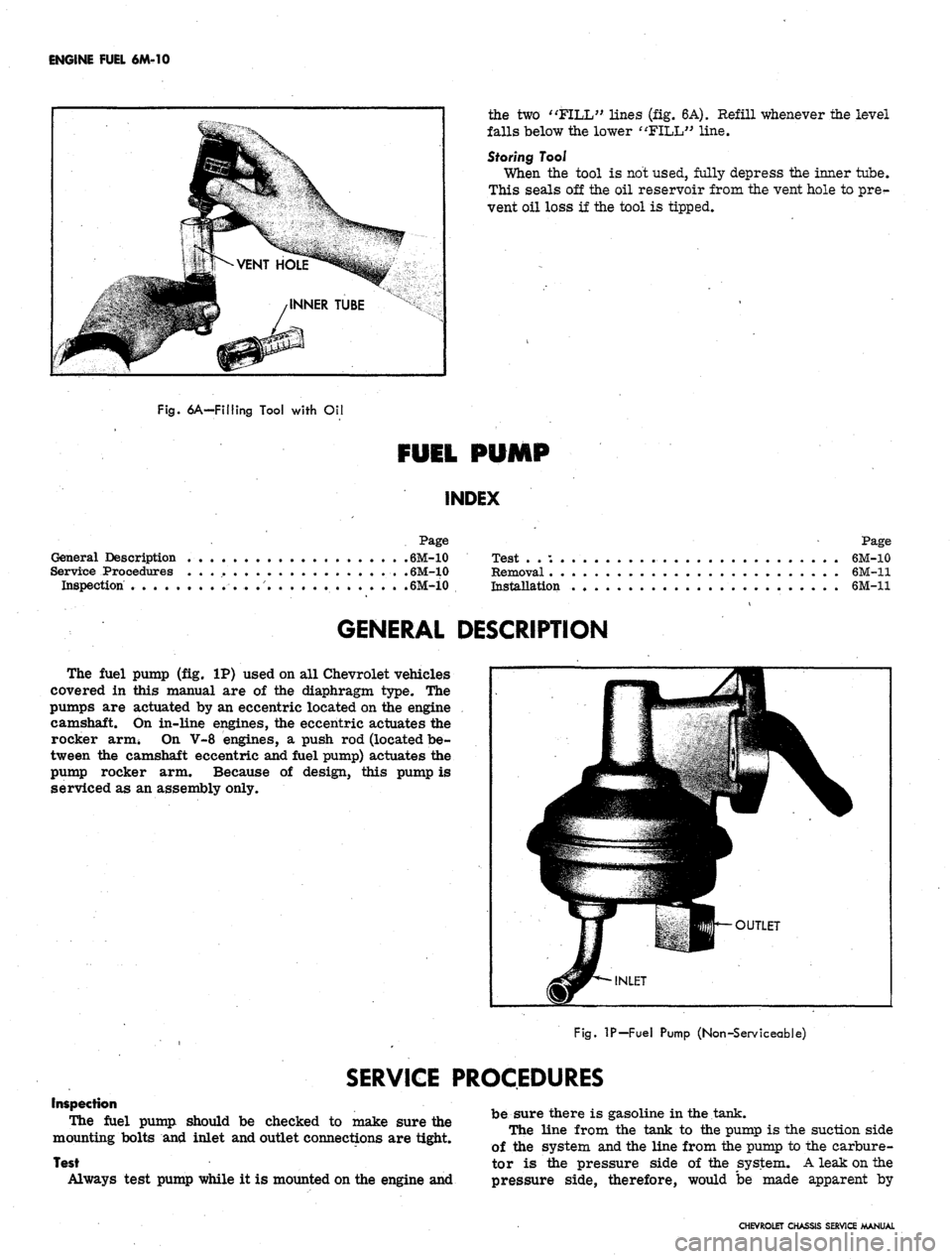
ENGINE FUEL
6M-10
the
two
"FILL71 lines
(fig.
6A). Refill whenever
the
level
falls below the lower
<'FILL"
line.
Storing Tool
When
the
tool
is
not used, fully depress
the
inner tube.
This seals
off
the
oil
reservoir from the vent hole
to pre-
vent
oil
loss
if
the tool
is
tipped.
Fig. 6A-Filling Tool with
Oil
FUEL PUMP
INDEX
Page
General Description
. . . . 6M-10
Service Procedures .6M-10
Inspection .6M-10
Page
Test
. . ; 6M-10
Removal
6M-11
Installation
6M-11
GENERAL DESCRIPTION
The fuel pump
(fig. IP)
used
on all
Chevrolet vehicles
covered
in
this manual
are of the
diaphragm type.
The
pumps
are
actuated
by an
eccentric located on
the
engine
camshaft.
On
in-line engines,
the
eccentric actuates
the
rocker arm*
On V-8
engines,
a
push
rod
(located be-
tween
the
camshaft eccentric and fuel pump) actuates
the
pump rocker
arm.
Because
of
design, this pump
is
serviced
as an
assembly only.
Fig.
IP—Fuel Pump (Non-Serviceable)
SERVICE PROCEDURES
Inspection
The fuel pump should
be
checked
to
make sure
the
mounting bolts
and
inlet and outlet connections
are
tight.
Test
Always test pump while
it is
mounted on the engine
and
be sure there
is
gasoline
in
the tank.
The line from
the
tank
to the
pump
is the
suction side
of
the
system and the line from the pump
to the
carbure-
tor
is the
pressure side
of the
system.
A
leak on
the
pressure side, therefore, would
be
made apparent
by
CHEVROLET CHASSIS SERVICE MANUAL
Page 319 of 659
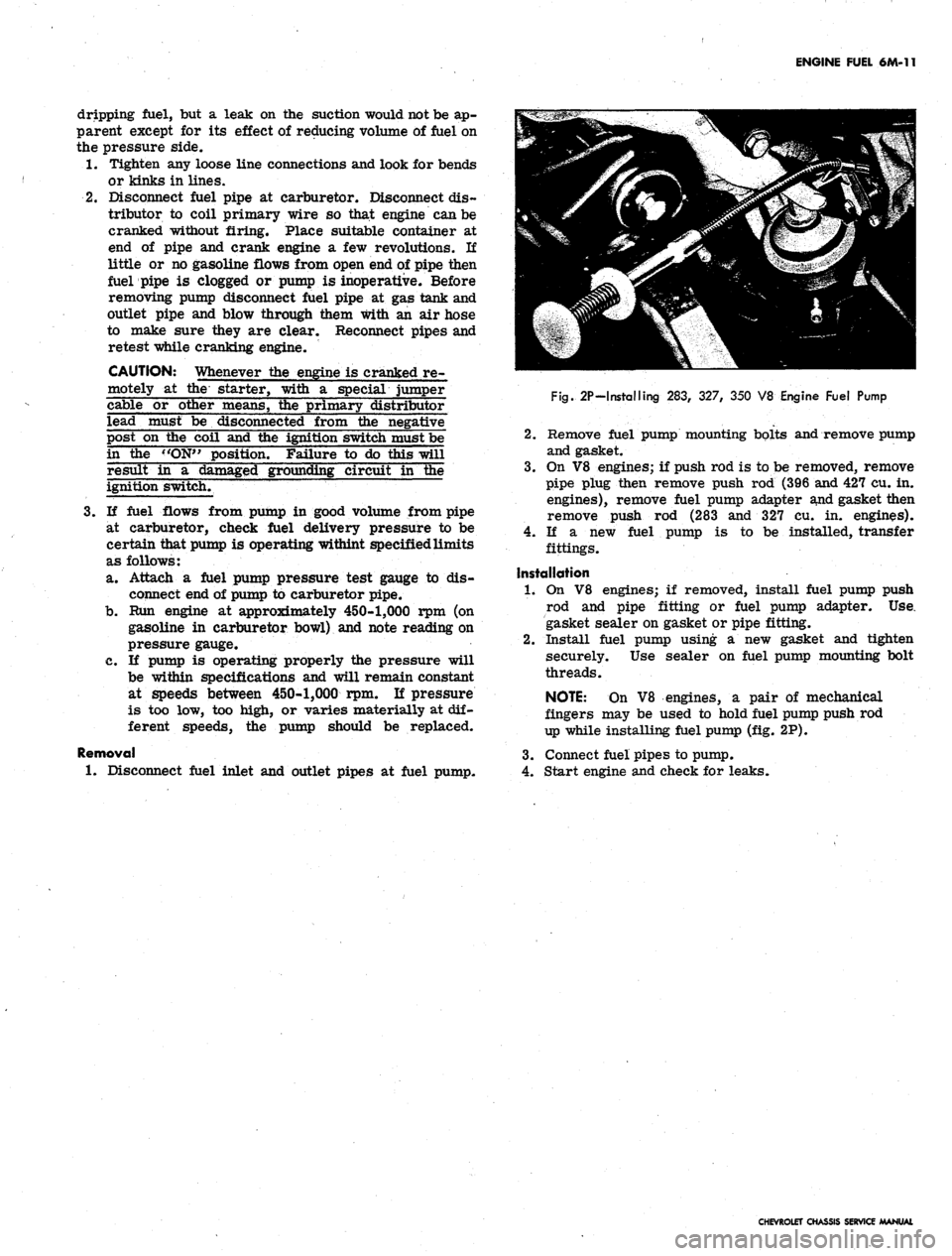
ENGINE FUEL 6M-11
dripping fuel, but a leak on the suction would not be ap-
parent except for its effect of reducing volume of fuel on
the pressure side.
1.
Tighten any loose line connections and look for bends
or kinks in lines.
2.
Disconnect fuel pipe at carburetor. Disconnect dis-
tributor to coil primary wire so that engine can be
cranked without firing. Place suitable container at
end of pipe and crank engine a few revolutions. If
little or no gasoline flows from open end of pipe then
fuel pipe is clogged or pump is inoperative. Before
removing pump disconnect fuel pipe at gas tank and
outlet pipe and blow through them with an air hose
to make sure they are clear. Reconnect pipes and
retest while cranking engine.
CAUTION: Whenever the engine is cranked re-
motely at the starter, with a special jumper
cable or other means, the primary distributor
lead must be disconnected from the negative
post on the coil and the ignition switch must be
in the "ON" position. Failure to do this will
result in a damaged grounding circuit in the
ignition switch.
3.
If fuel flows from pump in good volume from pipe
at carburetor, check fuel delivery pressure to be
certain that pump is operating withint specified limits
as follows:
a. Attach a fuel pump pressure test gauge to dis-
connect end of pump to carburetor pipe.
b.
Run engine at approximately 450-1,000 rpm (on
gasoline in carburetor bowl) and note reading on
pressure gauge.
c. If pump is operating properly the pressure will
be within specifications and will remain constant
at speeds between 450-1,000 rpm. If pressure
is too low, too high, or varies materially at dif-
ferent speeds, the pump should be replaced.
Removal
1.
Disconnect fuel inlet and outlet pipes at fuel pump.
Fig.
2P-Installing 283, 327, 350 V8 Engine Fuel Pump
2.
Remove fuel pump mounting bolts and remove pump
and gasket.
3.
On V8 engines; if push rod is to be removed, remove
pipe plug then remove push rod (396 and 427 cu. in.
engines), remove fuel pump adapter and gasket then
remove push rod (283 and 327 cu. in. engines).
4.
If a new fuel pump is to be installed, transfer
fittings.
Installation
1.
On V8 engines; if removed, install fuel pump push
rod and pipe fitting or fuel pump adapter. Use.
gasket sealer on gasket or pipe fitting.
2.
Install fuel pump using a new gasket and tighten
securely. Use sealer on fuel pump mounting bolt
threads.
NOTE:
On V8 engines, a pair of mechanical
fingers may be used to hold fuel pump push rod
up while installing fuel pump (fig. 2P).
3.
Connect fuel pipes to pump.
4.
Start engine and check for leaks.
CHEVROLET CHASSIS SERVICE MANUAL
Page 320 of 659
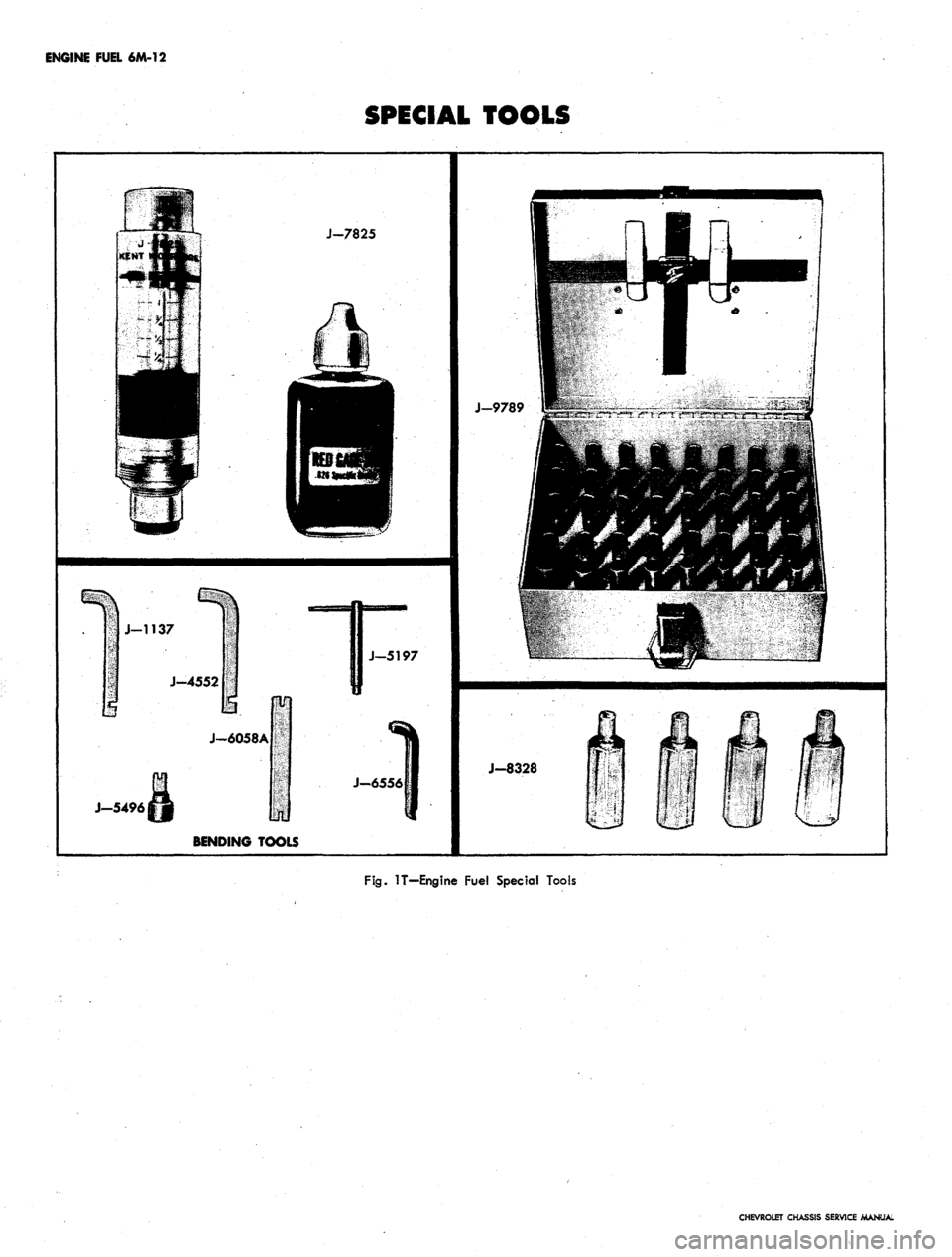
ENGINE FUEL
6M-12
SPECIAL TOOLS
—1137
J-4552
J-5496,
J-7825
15
J-6058A
BENDING
TOOLS
J-5197
J-6556
J-9789
J-8328
Fig.
lT-Engine Fuel Special Tools
CHEVROLET CHASSIS SERVICE MANUAL